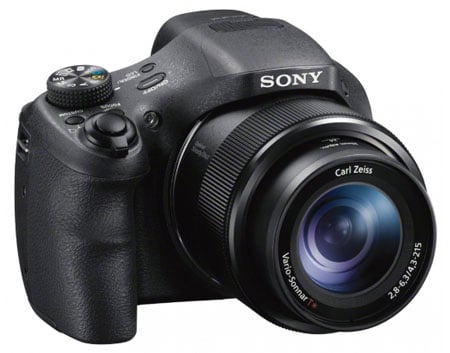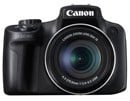Sony Cyber-shot HX300 review
-
-
Written by Ken McMahon
Verdict
The Sony Cyber-shot HX300 is Sony’s flagship compact super-zoom. It sits above the HX200, extending the zoom range to a whopping 50x, from a super-wide 24mm all the way to a 1200mm super-telephoto that any papparazzi would be proud of.
And the range isn’t the only impressive thing about the HX300’s lens. It has a bright f2.8 aperture at the wide angle setting and the improved image stablisation means you can get sharp shots hand-held in failing light even at the 1200mm telephoto end of the range at which point the aperture closes to f6.3.
Sony has gone all out for the big numbers and, in addition to a big zoom, they’ve increased the resolution of the HX300’s sensor which now boasts 20.4 Megapixels. That’s a lot of pixels to pack onto a compact sensor and, other than appealing to a certain kind of buyer, you have to wonder whether this is a sensible move. Sony could have stuck with the HX200’s 18 Megapixel sensor and still boasted a third higher resolution than the Canon SX50 HS. As it is you can make bigger prints, but while the numbers are getting bigger, the quality and noise performance aren’t getting any better.
Aside from the headline features, the HX300 provides a wide range of movie modes and, as you’d expect for a Cyber-shot, is packed with ‘gadget’ features like iSweep panorama, Picture Effects, 3D modes and stacking modes. But it’s hard not to feel a little disgruntled that some of the features of the HX100 and HX200 have been left out. I doubt too many people will even notice the lack of a built-in neutral density filter, but the eye sensor that automatically switches between the screen and EVF is a different matter. Sony’s policy on GPS and Wifi is also hard to fathom. The HX300 isn’t available with either, so if you want those you’ll have to compromise on the zoom range and opt for the GPS-only HX200V or indeed the more pocketable HX50V which has both GPS and Wifi, unless you live in the UK where neither are available.
Despite those inconsistencies, the Cyber-shot HX300 is great at what it does. But you need to be honest with yourself about how useful that top end of the telephoto range is going to be to you. Unless you do primarily wildlife or sport photography it could be that that a model with a more modest 40x, 30x, or even 24x zoom has more to offer.
 |
Compared to Canon PowerShot SX50 HS
 | ||
The big selling point of both the Canon PowerShot SX50 HS and the Sony Cyber-shot HX300 is their 50X zoom, so lets start with that. Both of these models offer exactly the same zoom range with a 35mm equivalent of 24-1200mm. The maximum aperture on the HX300 is slighlty brighter though, at f2.8 compared with f3.4 on the SX50 HS at the wide angle setting. As you zoom in though, the Sony’s advantage diminishes and at 1200mm they’re much closer- f6.3 on the HX300, f6.5 on the SX50 HS. You can zoom the HX300 using either the conventional collar on the shutter release or the zoom ring, which is nice. Though it lacks a lens ring, the SX50 HS has a clever framing assist feature which helps you locate your subject when zoomed in. But in terms of getting close in to your subject, they both perform equally well.
If you’re playing the numbers game, and Sony surely hopes people will, the next obvious comparison is sensor resolution – 20.4 Megapixels on the HX300 compared with 12.1 on the SX50 HS. But of course, we all know that doesn’t make the HX300 nearly twice as good, right? In fact, while all those additional pixels may well come in handy when you want to make A2 sized prints, they do nothing to enhance image quality or noise performance. In my tests, the SX50 came out on top for both. Having said that, the gap isn’t that big and this alone isn’t enough to choose one over the other. But something that may make a bigger difference to you is the ability of the SX50 HS to shoot RAW.
The HX300 has a higher resolution 3 inch 921k dot screen but, though it’s smaller and has roughly only half the number of dots, I found the 461k dot 2.8 inch LCD screen of the SX50 HS easier to see when shooting outdoors in bright conditions. The SX50 HS’s screen is side-hinged, which means you can point it in any direction including front-facing, whereas the HX300’s is limited to up and down movement. Both models have similar electronic viewfinders and neither has an eye sensor to automatically switch between the screen and EVF – you have to push a button, but the HX300 at least has a dedicated button, with the SX50 HS you have to cycle through modes with the display button. Both have a built in flash, but the SX50HS also has a hotshoe so you can mount an external flash if the built-in one isn’t powerful enough for you.
There’s a similar range of shooting modes on offer with both models offering PASM control, fully auto modes with scene detection, a range of scene modes and filter effects. The HX300 has iSweep panorama and 3D modes, but the SX50 HS’s Creative filters are more versatile, you can preview them and apply more of them, including the Miniature effect, to video.
And when it comes to video, though the HX300 has more modes and can shoot 1080p video at 50/60fps compared with 24fps on the SX50 HS, the latter is, again, more versatile. Neither offers manual exposure control, but you can select a scene mode for movie recording. But the SX50 HS has the fun movie digest mode as well as a range of slow motion options, albeit at reduced resolution.
If you’ve decided you need a massive zoom range that covers the range from super-wide-angle to super-telephoto, neither of these models will disappoint you and there probably aren’t many situations in which one will out perform the other by any kind of measure that matters. The differences are in the handling and the mix of features that they provide. The SX50 HS is smaller and lighter, has a slightly more versatile screen, a hotshoe, RAW shooting and a more easily navigable menu system. The HX300 is chunkier, has a wider choice of video modes but fewer video features, and less versatile filters, but more ‘gadget’ features.
See my Canon SX50 HS review for more details.
Sony Cyber-shot HX300 final verdict
The Cyber-shot HX300 is a camera designed with one purpose in mind – to provide an extraordinarily long zoom range. To look at it another, more cynical way, it’s Sony’s competition for the Canon SX50 HS. There’s no denying that having a hugely powerful zoom at your fingertips provides the opportunity to get the kind of close-in, tightly framed shots that owners of more more moderate super-zooms can only dream of. For that, with its massive range, bright maximum aperture and excellent stabilisation, the HX300 is the ideal tool, but do closely compare the feature-set with Canon’s SX50 HS to see which best suits your needs.
But before even that, ask yourself if you really need the power of a 1200mm telephoto. Because if you don’t there are numerous other options that might suit you better. The first place to look would be the 30x Sony HX200 or the GPS equipped Sony HX200V. In return for a shorter zoom with a ‘mere’ 810mm telephoto, you gain longer battery life, an eye sensor, and a built-in ND filter in a smaller, lighter and cheaper body. There’s also the Sony HX50V which packs a 30x optical zoom into a pocket body, or of course the Panasonic Lumix FZ200 which may ‘only’ have a 25-600mm equivalent zoom, but boasts a constant focal ratio of f2.8 throughout the range. So while I can Recommend the HX300, there are a lot of compelling alternatives, most obviously starting with Canon’s SX50 HS, but including many others.
|
Good points Huge 50x 24-1200mm zoom range. Excellent optical image stabilisation. Articulated 3 inch LCD screen. Dial mode focus/zoom lens ring.  Bad points | Scores (relative to 2013 super-zooms) | |||
Build quality: Image quality: Handling: Specification: Value: Overall:
|
17 / 20 16 / 20 16 / 20 17 / 20 16 / 20 82% | |||




